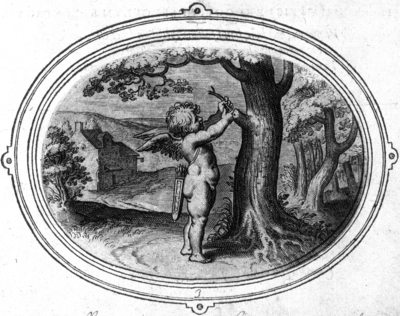Otto Vaenius, Amorum emblemata (1608)
Table of contents ↑Crescent illæ, crescetis amores [3]

Translations
 |
Vergilius, Eclogae 10, 54
Zij zullen groeien, zoals ook jij, mijn liefde, zult groeien. [cf. Cats, Sinne- en minnebeelden] |
 |
Vergilius, Eclogae 10, 54
They will grow, you, too, my love, will grow. [cf. Cats, Sinne- en minnebeelden] |
 |
Gelukkige inkerving waardoor de ene tak de andere aanneemt en die van twee bomen er één maakt. Zo verbindt de liefde twee
geliefden aanéén: ze willen hetzelfde wel en niet. |
 |
Happy ingrafting, by which one branch adopts the other and which makes two trees to become one. In the same way love joins
two lovers to be one, that both want and do not want the same things. |
Sources and parallels
- Crescent illæ, crescetis amores [3]
 (in: Otto Vaenius, Emblemata aliquot selectiora amatoria (1618)
(in: Otto Vaenius, Emblemata aliquot selectiora amatoria (1618) )
[Compare
)
[Compare ]
]
- Vijfde Verdeeling. [5]
 (in: Jan Luyken, Duytse lier (1671)
(in: Jan Luyken, Duytse lier (1671) )
[Compare
)
[Compare ]
]
- Vaenius's motto quoted in pictura: Sensim amor sensus occupat. [6]
 (in: Jacob Cats, Sinne- en minnebeelden (1627)
(in: Jacob Cats, Sinne- en minnebeelden (1627) )
[Compare
)
[Compare ]
]
- Grafting branch (woman) from one tree (her father) on another tree (her husband): Iam plenis nubilis annis. [45]
 (in: Jacob Cats, Sinne- en minnebeelden (1627)
(in: Jacob Cats, Sinne- en minnebeelden (1627) )
[Compare
)
[Compare ]
]
- Spiritual use of the grafting motif: Noli altum sapere [91]
 (in: Georgette de Montenay/Anna Roemer Visscher, Cent emblemes chrestiens (c. 1615)
(in: Georgette de Montenay/Anna Roemer Visscher, Cent emblemes chrestiens (c. 1615) )
[Compare
)
[Compare ]
]
- Volkomen een, altijd gemeen [4]
 (in: Pieter Huygen, Beginselen van Gods Koninkrijk (1689)
(in: Pieter Huygen, Beginselen van Gods Koninkrijk (1689) )
[Compare
)
[Compare ]
]
-
Parallel for the pictura (the emblem carries another message): Les deux sont un [19]
 (in: Daniël Heinsius, Quaeris quid sit Amor (c. 1601)
(in: Daniël Heinsius, Quaeris quid sit Amor (c. 1601) )
[Compare
)
[Compare ]
]
-
Parallel for the pictura (though the emblem carries another message): Les deux sont un [19]
 (in: Daniël Heinsius, Emblemata amatoria (1607/8)
(in: Daniël Heinsius, Emblemata amatoria (1607/8) )
[Compare
)
[Compare ]
]
-
Parallel for the pictura (mirrored) and the Latin and French motto in: Un Amour qui greffe
 (in: Daniel de la Feuille, Devises et emblemes (1691)
(in: Daniel de la Feuille, Devises et emblemes (1691) )
[Compare
)
[Compare ]
]
-
Spiritual use of the grafting motif in Luyken's comment in: De Ziele spreeckt van de loutere vereeniginge met Godt [29]
 (in: Jan Luyken, Jesus en de ziel (1685)
(in: Jan Luyken, Jesus en de ziel (1685) )
[Compare
)
[Compare ]
]
-
Motto and subscriptio similar to: Alciato, Book of Emblems
 , embl. 112
, embl. 112
-
Grafting the tree in: Les deux sont un. [41]
 (in: Daniël Heinsius, Ambacht van Cupido, from: Nederduytsche poemata (1616)
(in: Daniël Heinsius, Ambacht van Cupido, from: Nederduytsche poemata (1616) )
[Compare
)
[Compare ]
]
References, across this site, to this page:
- Noli altum sapere [91]
 (in: Georgette de Montenay/Anna Roemer Visscher, Cent emblemes chrestiens (c. 1615)
(in: Georgette de Montenay/Anna Roemer Visscher, Cent emblemes chrestiens (c. 1615) )
)
- Sensim amor sensus occupat. [6]
 (in: Jacob Cats, Sinne- en minnebeelden (1627)
(in: Jacob Cats, Sinne- en minnebeelden (1627) )
)
- Iam plenis nubilis annis. [45]
 (in: Jacob Cats, Sinne- en minnebeelden (1627)
(in: Jacob Cats, Sinne- en minnebeelden (1627) )
)
- Un Amour qui greffe
 (in: Daniel de la Feuille, Devises et emblemes (1691)
(in: Daniel de la Feuille, Devises et emblemes (1691) )
)
- Les deux sont un [19]
 (in: Daniël Heinsius, Quaeris quid sit Amor (c. 1601)
(in: Daniël Heinsius, Quaeris quid sit Amor (c. 1601) )
)
- Les deux sont un [19]
 (in: Daniël Heinsius, Emblemata amatoria (1607/8)
(in: Daniël Heinsius, Emblemata amatoria (1607/8) )
)
- Les deux sont un. [41]
 (in: Daniël Heinsius, Ambacht van Cupido, from: Nederduytsche poemata (1616)
(in: Daniël Heinsius, Ambacht van Cupido, from: Nederduytsche poemata (1616) )
)
- Volkomen een, altijd gemeen [4]
 (in: Pieter Huygen, Beginselen van Gods Koninkrijk (1689)
(in: Pieter Huygen, Beginselen van Gods Koninkrijk (1689) )
)
- Vijfde Verdeeling. [5]
 (in: Jan Luyken, Duytse lier (1671)
(in: Jan Luyken, Duytse lier (1671) )
)
- De Ziele spreeckt van de loutere vereeniginge met Godt [29]
 (in: Jan Luyken, Jesus en de ziel (1685)
(in: Jan Luyken, Jesus en de ziel (1685) )
)
- Crescent illæ, crescetis amores [3]
 (in: Otto Vaenius, Emblemata aliquot selectiora amatoria (1618)
(in: Otto Vaenius, Emblemata aliquot selectiora amatoria (1618) )
)

